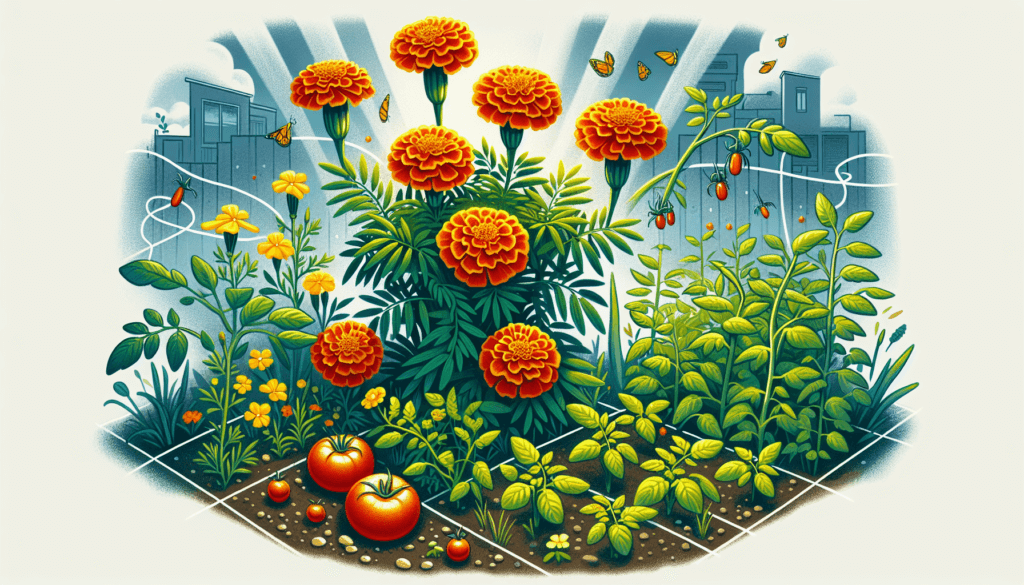Are you looking to maximize the productivity and beauty of your urban garden, but unsure of how to achieve it? Look no further! This article explores the concept of incorporating companion planting in your urban garden to create a harmonious and thriving ecosystem. By strategically placing compatible plants together, you can enhance pollination, deter pests, and promote healthier growth. Discover the secrets of companion planting and unlock the potential of your urban garden today!

Benefits of Companion Planting
Companion planting is a gardening technique that involves growing different plants together, taking advantage of the positive relationships they can form. By incorporating companion planting in your urban garden, you can enjoy a multitude of benefits.
Increasing biodiversity
One of the major benefits of companion planting is the increase in biodiversity it brings to your garden. By growing a variety of plant species, you invite a wide range of organisms, such as insects and beneficial microorganisms, to thrive in your garden. This biodiversity not only enhances the overall health of your garden ecosystem but also helps maintain a balanced and sustainable environment.
Natural pest control
Companion planting can also serve as a natural pest control strategy. Some plants naturally repel pests, while others attract predatory insects that feed on pests. By strategically choosing companion plants that repel or attract certain insects, you can effectively control pests in your garden without relying on harmful chemicals.
Improving soil fertility
Certain plant combinations can enhance soil fertility by utilizing different nutrients and preventing nutrient depletion. For example, legumes, such as peas and beans, have the ability to fix nitrogen from the air, which benefits neighboring plants that require nitrogen for growth. Additionally, some plants have deep roots that help break up compacted soil, improving overall soil structure and nutrient uptake.
Choosing Complementary Plants
To make the most out of companion planting, it is important to understand the relationships between different plant species. Here are some key factors to consider when choosing complementary plants for your garden.
Understanding plant relationships
Different plants have different needs and abilities, and understanding their relationships can help you create harmonious planting combinations. Some plants release natural compounds that can inhibit the growth of certain pests or diseases, while others attract beneficial insects that provide pollination or pest control services. By studying plant relationships, you can make informed decisions about which plants to grow together.
Identifying beneficial companions
Certain plants have natural affinities for one another and thrive when grown together. For example, tomatoes and basil are often touted as excellent companion plants because basil is believed to improve the flavor of tomatoes while repelling pests that commonly affect tomato plants. Similarly, carrots and onions are known to benefit from being grown together, as onions can deter carrot fly.
Avoiding harmful combinations
Just as some plants benefit from being grown together, others should be kept apart. Some plants emit chemicals that can hinder the growth of nearby plants, a phenomenon known as allelopathy. For example, planting beans and onions together can inhibit the growth of both plants. It is important to research potential harmful combinations and avoid planting them in close proximity.
Creating a Planting Plan
When incorporating companion planting in your garden, it is essential to develop a well-thought-out planting plan. Here are some strategies to consider when creating your plan.
Grouping plants based on compatibility
To maximize the benefits of companion planting, group plants with similar needs and compatibility together. Take into consideration factors such as sunlight requirements, soil preferences, and growth patterns. Grouping compatible plants allows you to create a harmonious ecosystem and optimize space utilization.
Utilizing vertical space efficiently
In urban gardens with limited space, utilizing vertical space is key. Some plants, like cucumbers and pole beans, thrive when provided with structures such as trellises or stakes to climb on. By growing vertically, you can increase your planting space and create a visually appealing garden.
Implementing succession planting
Succession planting involves staggering the planting of crops to ensure a continuous harvest throughout the growing season. By carefully planning which plants will be grown together and when to plant them, you can optimize space and maximize productivity. For example, after harvesting lettuce, you can plant spinach or other leafy greens in the same space to ensure a continuous supply of fresh greens.
Popular Companion Plant Combinations
Certain companion plant combinations have been tried and tested over the years and have gained popularity among gardeners. Here are some popular combinations that are known to work well together.
Tomatoes and basil
Tomatoes and basil are a classic example of companion planting. Basil is believed to enhance the flavor of tomatoes while also repelling pests like aphids and tomato hornworms. Plant basil around your tomato plants to enjoy the benefits of this harmonious combination.
Carrots and onions
Carrots and onions make excellent companions in the garden. Onions act as a natural deterrent for carrot fly, which can damage carrot crops. Interplanting onions between rows of carrots can help protect your crop from this common pest while utilizing space efficiently.
Lettuce and radishes
Lettuce and radishes are another great combination. Radishes have a quick growing cycle and can be harvested before lettuce reaches its full size. By planting radishes alongside lettuce, you can make the most of your garden space and enjoy a variety of fresh greens.

Companion Planting Techniques
To effectively incorporate companion planting in your garden, it is important to familiarize yourself with different techniques. Here are three popular companion planting techniques to consider.
Interplanting
Interplanting involves growing different plant species together in the same area, maximizing space utilization. For example, you can plant lettuce between rows of broccoli or radishes between rows of carrots. Interplanting also helps diversify the garden ecosystem and promote overall plant health.
Bordering and edging
Creating borders or edges using specific companion plants can help deter pests and attract beneficial insects. For instance, planting marigolds around the perimeter of your garden can help repel harmful insects like nematodes while attracting pollinators. Experiment with different bordering and edging plants to find the combinations that work best for your garden.
Trap cropping
Trap cropping involves planting a sacrificial plant to attract pests away from your desired crops. For example, planting marigolds near a crop that is prone to aphid infestation can divert the aphids to the marigolds, preserving the health of your main crop. Trap cropping can be an effective strategy to minimize pest damage in your garden.
Attracting Beneficial Insects
Beneficial insects play a vital role in any garden ecosystem. By attracting these insects to your urban garden, you can promote pollination, pest control, and overall balance. Here are some ways to attract beneficial insects through companion planting.
Flowering plants for pollinators
Including flowering plants in your garden that attract pollinators, such as bees and butterflies, can significantly increase the fruit set and yield of your plants. Consider planting flowers like lavender, sunflowers, and bee balm to attract these important pollinators.
Herbs to attract beneficial insects
Many herbs have the ability to attract beneficial insects. For example, planting fennel can attract ladybugs, lacewings, and hoverflies, all of which are natural predators of common garden pests. By including herbs like fennel, dill, and cilantro in your garden, you create a welcoming environment for these helpful insects.
Repelling harmful insects
Companion planting can also be used to repel harmful insects. For instance, planting marigolds, nasturtiums, or garlic alongside your vegetable crops can help deter pests like aphids, whiteflies, and nematodes. These companion plants emit natural compounds that repel pests, reducing the need for chemical interventions.

Companion Planting with Herbs and Flowers
Herbs and flowers can be valuable additions to your companion planting strategy. Here are some popular herb and flower combinations that work well together.
Dill and cabbage
Planting dill alongside cabbage can benefit your cabbage crop in multiple ways. Dill attracts beneficial insects like predatory wasps and pollinators, while also repelling pests like cabbage worms. This combination can help maintain the health and productivity of your cabbage plants.
Marigolds and tomatoes
Marigolds are known for their pest-repellent properties and can be a great companion for tomato plants. Planting marigolds around your tomato plants can help deter pests like nematodes and whiteflies, while also adding a vibrant splash of color to your garden.
Chamomile and onions
Chamomile and onions are another compatible pair. Chamomile attracts beneficial insects like hoverflies and parasitic wasps, which prey on pests that commonly affect onions. Additionally, chamomile acts as a natural fungicide, helping to prevent fungal diseases in your onion crop.
Companion Planting in Containers
Companion planting is not limited to traditional garden beds. It can also be implemented in container gardens, making it accessible to those with limited space. Here are some considerations for companion planting in containers.
Choosing appropriate container sizes
When planning companion planting in containers, it is important to choose appropriate container sizes for your plants. Different plant species have different space requirements, and overcrowding can hinder their growth. Ensure that each plant has enough room to develop its root system and access the necessary resources.
Planting combinations for limited space
In a small container garden, maximizing space utilization is crucial. Consider growing vertical plants, such as pole beans or cucumbers, alongside compact varieties of tomatoes or herbs. Pairing plants with different heights and growth habits can make the most of your limited space.
Caring for container gardens
Container gardens require special attention in terms of watering, fertilizing, and maintenance. Ensure that your containers have proper drainage to prevent waterlogging, and water your plants regularly to maintain soil moisture. Regularly fertilize according to the specific needs of your plants, and monitor for any signs of pest or disease issues.

Maintaining a Healthy Companion Garden
To ensure the long-term success of your companion garden, regular maintenance is crucial. Here are some key practices to incorporate into your gardening routine.
Regular watering and mulching
Consistent watering is essential to keep your plants healthy and productive. Monitor soil moisture levels and water as needed, taking into account the specific requirements of each plant. Mulching can help conserve moisture, suppress weed growth, and moderate soil temperature, contributing to overall plant health.
Weeding and pruning
Regular weeding is essential to prevent competition for resources and reduce the likelihood of pest and disease issues. Remove any unwanted plants or weeds that may be growing alongside your desired crops. Additionally, pruning plants when necessary helps maintain their shape, promote airflow, and prevent overcrowding.
Crop rotation and soil amendments
To prevent nutrient depletion and reduce the risk of soil-borne diseases, practice crop rotation in your companion garden. Rotate plants in different families to prevent the buildup of pests and diseases. Additionally, periodically amend the soil with organic matter, such as compost or well-rotted manure, to replenish nutrients and improve soil fertility.
Common Mistakes to Avoid
As with any gardening practice, there are common mistakes that gardeners can make when incorporating companion planting. Here are a few key mistakes to avoid.
Overcrowding plants
It can be tempting to maximize space by planting too many plants together. However, overcrowding can lead to competition for resources, hinder air circulation, and promote pest and disease issues. Ensure that each plant has enough space to grow and develop properly.
Ignoring plant compatibility
Plant compatibility is key to the success of companion planting. Ignoring plant compatibility can result in poor growth, decreased productivity, and increased vulnerability to pests and diseases. Take the time to research and plan your companion planting combinations based on the specific needs and affinities of each plant.
Neglecting regular maintenance
Like any garden, a companion garden requires regular maintenance to thrive. Neglecting tasks such as watering, weeding, pruning, and pest control can lead to a decline in plant health and productivity. Establish a routine of regular garden care to ensure the long-term success of your companion garden.
In conclusion, incorporating companion planting in your urban garden can bring a multitude of benefits, from increasing biodiversity to natural pest control and improved soil fertility. By understanding plant relationships, choosing complementary plants, and creating a well-thought-out planting plan, you can maximize the success of your companion garden. Whether you opt for popular combinations, utilize various companion planting techniques, or attract beneficial insects, companion planting offers a sustainable and holistic approach to gardening. With proper care and maintenance, your companion garden can thrive and provide you with an abundant harvest year after year. Happy companion planting!



